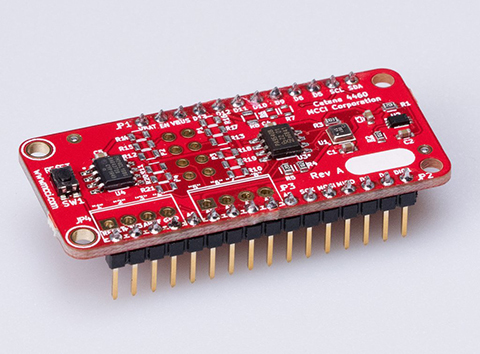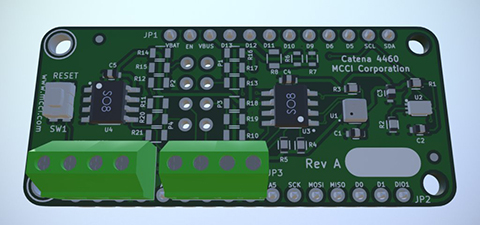Catena 4460
Sensor Wing w/ BME680 VOC Sensor
for LoRaWAN® Technology
The MCCI Catena® 4460 Sensor Wing is a flexible open-source IoT device wing designed specifically for use with the Adafruit Feather M0 with LoRa® radiosystem, but suitable for use with any Adafruit Feather CPU board. Like the Catena 4450, when combined with a suitable CPU, it is a ready-to-use platform for LoRaWAN® 1.0 and 1.1 wireless IoT applications.
Its key feature is integration of a Bosch BME680 Integrated Environmental Sensor, capable of monitoring temperature, humidity, pressure, and volatile organic compounds (VOC). When used with suitable drivers, the BME680 can produce a simple air-quality index. The following table indicates output from the Bosch proprietary drivers.

Similar results can be obtained using the gas resistance measured by the open-source library.
The Catena 4460 sensor wing has the following features.
- Bosch BME680 environmental sensor, measuring temperature, humidity, barometric pressure and gas resistance;
- Rohm BH1750 lux sensor, measuring from 0 to 65,536 lux of ambient light.
- 2 kbytes of ferro-electric RAM (FRAM) for non-volatile storage of network parameters, session keys, and application data (fully meeting requirements of LoRaWAN 1.0.2 and 1.1).
- Integrated jumpers to make the Feather M0 LoRa work with the Arduino LMIC without further modification or wiring -- just plug on the Catena 4460.
- An I2C expansion multiplexer, for adding additional I2C devices externally.
- Provisions for screw terminals (not included) for terminating external sensors.
The WING-ONLY variant is the Catena 4460 wing only. It does not include the CPU board, nor does it include headers or screw terminals. It is great for experimenters who want to breadboard more complex solutions.
The DIY-KIT is a complete IoT node ready for assembly. It includes:
- Catena 4460 board
- Adafruit Feather M0 with 850-923 MHz LoRa radio and header pins
- Female headers (12 and 16 pin)
- 350 mAh LiPo battery
- Two 4-position screw terminals
- 64-bit EUI sticker
- Whip antennas for 866, 868, and 915 MHz.
All you need to do is solder it together (takes about half an hour), add is a USB cable and the Arduino development environment, and you're ready to take measurements.
The DIY-FACTORY is the same as the DIY-KIT, except that it's fully assembled and tested by MCCI.
Software is available.
Contact us for more details.
Volume discounts and custom variants are available.
About
For over twenty years we've been developing and licensing USB system software to be embedded into our customers’ consumer-electronics products.
Contact
Use our contact page to connect with us. We will work with you to meet your needs.
Updates
Stay up to date with our work and get updates delivered right to your inbox.


